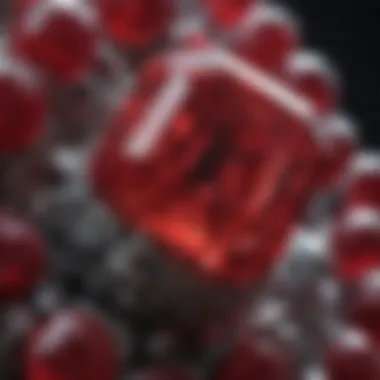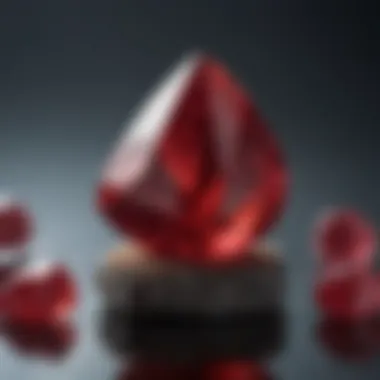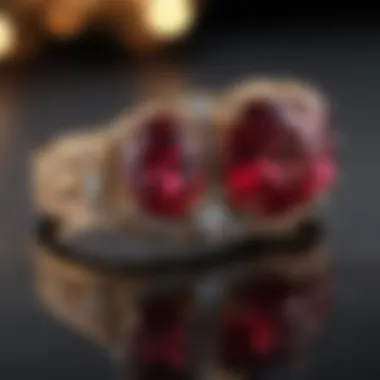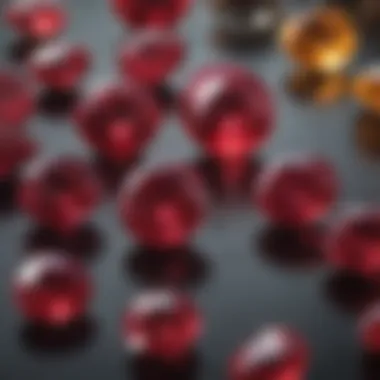Understanding Ruby Hardness: An In-Depth Exploration


Intro
Rubies are one of the most valued gemstones worldwide. Their appeal stems from their vibrant color, rarity, and hardness. Understanding ruby hardness possesses significance not just for consumers but also for jewelers and gemstone collectors. Hardness affects how rubies are used in jewelry and influences their market value. As we delve deeper into this topic, we will explore the scientific aspects, the Mohs scale, and factors affecting durability, thus providing clarity on what makes rubies a fascinating choice in the gemstone realm.
Gemstone Overview
Definition and Characteristics
A ruby is a variety of corundum, primarily composed of aluminum oxide. The deep red color arises from the presence of chromium. Hardness is a defining characteristic of rubies. On the Mohs scale, rubies score a 9, ranking just below diamonds. This attribute makes them both durable and suitable for various applications.
Ranging in color, rubies can exhibit shades from pinkish-red to blood-red. Their clarity and size also significantly impact their quality and value. The presence of inclusions can diminish the gem's overall worth, but some inclusions can add value by indicating origin or uniqueness.
Classification of Gemstones
Gemstones fall into two main categories: precious and semi-precious. Rubies are classified as a precious gemstone, alongside sapphires, emeralds, and diamonds. This classification is primarily due to their beauty, durability, and rarity. In contrast, semi-precious stones, like amethyst and topaz, while beautiful, do not possess the same level of hardness or market demand.
- Precious Gemstones
- Semi-Precious Gemstones
- Rubies
- Sapphires
- Emeralds
- Diamonds
- Amethyst
- Topaz
- Garnet
Historical Significance
Ancient Uses and Cultural Importance
Historically, rubies have held a prominent position in different cultures. Ancient civilizations believed that rubies provided protection and encouraged courage. They often adorned crowns and were thought to hold magical properties. In Burma, rubies were associated with bravery and were worn by warriors heading into battle.
Myths and Legends Surrounding Gemstones
Rubies are surrounded by numerous myths and legends. In medieval Europe, people believed that wearing a ruby would bring peace and prosperity. The gem was thought to protect its owner from misfortune, sickness, and even injury. Such beliefs have reinforced the status of rubies as a symbol of wealth and power.
"The ruby's brilliance and depth of color have inspired tales of heroism and wealth throughout history."
In summary, understanding ruby hardness gives valuable insights not only into their market value but also into their historical significance in various cultures. This exploration will equip readers with knowledge essential for informed decisions in the world of gemstones.
Prelims to Ruby Hardness
Understanding ruby hardness is fundamental when exploring the world of gemstones. Hardness indicates a gemstone's ability to resist scratching and other forms of damage. This property is essential not just for collectors, but also for artisans and jewelers who design and craft pieces that will withstand the test of time. Knowing the hardness of a ruby helps in making informed choices regarding the selection and care of these exquisite stones.
Defining Hardness in Gemstones
Hardness in gemstones is primarily determined by their atomic structure and bonding characteristics. The Mohs hardness scale, developed by Frederick Mohs, is a widely used method to rank the hardness of minerals. It ranges from 1 (talc) to 10 (diamond), measuring a mineral's resistance to scratching. For rubies, which are a variety of corundum, the hardness rating is 9 on this scale. This high rating positions rubies just below diamonds, indicating they are quite resilient and ideal for various jewelry applications.
The definition of hardness invokes a deeper understanding of how gemstones engage with their environment. It is not merely about toughness but also about the wear that can occur over time. As rubies are subjected to daily use, the need for their robust hardness becomes apparent.
Importance of Hardness in Gemology
In gemology, hardness plays a critical role in assessing a gemstone's suitability. For example:
- Durability: The ability of a ruby to maintain its pristine condition increases its appeal and market value.
- Setting Choices: Jewels must be durable enough to withstand general wear and tear, especially in rings and bracelets.
- Care Practices: Knowledge of a stone's hardness informs cleaning methods and settings that can be safely used.
"The hardness of a gemstone significantly influences both its beauty and longevity. It shapes the decision-making processes of collectors and designers alike."


Additionally, a gem's hardness may impact its valuation in the marketplace. Stones with higher hardness ratings generally command higher prices due to their desirability and durability. Thus, for gemstone enthusiasts and professionals, understanding ruby hardness is not just academic; it directly translates into practical considerations for care, selection, and investment.
The Science Behind Hardness
Understanding the science behind hardness is essential to grasp how rubies, and gemstones in general, are assessed. Hardness determines not only the durability of these gems but also their market value. A high hardness rating can influence decisions made by jewellers and consumers alike. For rubies, which are prized for their vibrant colors and rarity, understanding this attribute is key to appreciating their overall worth and applications.
Understanding Atomic Structure
At the core of hardness lies atomic structure. The arrangement of atoms in a material influences how strong or durable that material can be. In rubies, the primary component is corundum, which is a crystalline form of aluminum oxide. The atomic bonding within corundum is particularly strong due to the way aluminum and oxygen atoms are structured. This stability contributes to the overall hardness of the gem.
The triangular shape of the corundum crystal lattice is another reason why rubies are incredibly resilient. The stronger the atomic structure, the less likely the material is to deform under pressure or scratch. This relationship between atomic structure and hardness underpins why rubies rank so high on the Mohs scale.
Types of Hardness: A Closer Look
Hardness can be categorized into different types, mainly scratch hardness and indentation hardness. Each type provides unique insights into how a material withstands various forms of stress.
Scratch Hardness
Scratch hardness is the capability of a material to resist being scratched by another substance. This aspect is particularly relevant when considering the practical usage of rubies in jewelry. For example, rubies can easily withstand everyday wear because they do not get scratched by common materials like metal or other gemstones.
Key characteristic of scratch hardness: It is measured by comparing materials to one another based on their ability to scratch one another. Rubies score a 9 on the Mohs scale, just below diamond, making them ideal for everyday jewelry because they retain their brilliance and surface integrity over time.
United feature of scratch hardness: The fact that rubies do not easily scratch means they can maintain their luster much longer than softer gemstones, making them appealing to jewelers and consumers alike. However, a downside is that while rubies themselves are resistant to scratching, they can still chip if they are hit at the right angle.
Indentation Hardness
Indentation hardness refers to how a material behaves when subjected to pressure. It evaluates a gem's ability to resist deformation when a heavy object presses against it. For rubies, this type of hardness is also high, contributing to their durability in various applications, particularly in settings where they are subjected to pressure.
Key characteristic of indentation hardness: Unlike scratch hardness, this measure focuses on how a gem reacts under concentrated force rather than a sliding motion. Rubies generally show significant resistance to indentations, which further emphasizes their practicality in jewelry design.
Unique feature of indentation hardness: This property ensures that rubies can be set in intricate designs without fear of them easily losing their shape. A potential disadvantage is that extreme pressure or force can still cause some structural failure over time, especially in poorly made settings.
"The combination of both scratch hardness and indentation hardness makes rubies an ideal choice for high-quality jewelry and collectors alike, solidifying their status as a premium gemstone in the market."
The Mohs Hardness Scale
The Mohs Hardness Scale serves as a pivotal reference for understanding the hardness of gemstones, including rubies. This scale quantifies the resistance of minerals to scratching, providing a relative ranking from 1 to 10, where talc ranks as the softest (1) and diamond as the hardest (10). For gemologists, this scale is essential not only for categorizing gemstones but also for practical applications in jewelry design and mineral identification.
By examining the Mohs scale, one also gains insights into why some gemstones are more suited for particular uses than others. The scale fosters an understanding of durability, which is crucial for both buyers and sellers in the gemstone market. Knowing a stone’s place on the scale helps to inform decisions regarding care, maintenance, and pricing.
Overview of the Mohs Scale
The Mohs Hardness Scale was developed by Friedrich Mohs in 1812. It ranks minerals based on their ability to scratch one another. Each mineral can scratch those ranked below it and can be scratched by those ranked above. The scale includes familiar minerals:
- Talc (1)
- Gypsum (2)
- Calcite (3)
- Fluorite (4)
- Apatite (5)
- Orthoclase Feldspar (6)
- Quartz (7)
- Topaz (8)
- Corundum (9)
- Diamond (10)
This simple system creates a baseline for understanding hardness without the need for complex measurements. For gemstones like rubies, which fall at 9 on the scale, this suggests significant resistance to scratching and wear, underlining their desirability in jewelry and ornamentation.
Ruby's Position on the Scale
Rubies are classified at the 9 position on the Mohs Hardness Scale. This position indicates that rubies are highly resistant to scratches from most materials. A ruby's hardness is due to its crystalline structure, primarily composed of corundum, which contributes to its strength. This makes rubies suited for everyday jewelry use as they can withstand daily wear and tear.
Moreover, the hardness classification is integral for jewelers and designers. It informs them about how rubies will perform in different settings and environments, assisting in the creation of durable pieces that maintain their beauty over time.


Comparing Ruby with Other Gemstones
In the context of the Mohs scale, comparing rubies with other gemstones helps illuminate their unique properties and uses. Key comparisons include:
Sapphire
Sapphire also rates a 9 on the Mohs scale, sharing significant hardness with rubies. Its diverse colors, most notably blue, make it a popular choice for jewelry. Sapphires' high durability ensures they remain intact over years of wear. Additionally, they come in various hues, appealing to different tastes. However, sapphires may exhibit inclusions, which can affect their market value.
Emerald
Emeralds rank lower on the scale at 7. Though beautiful, their lower hardness means they are more susceptible to scratching and damage. This characteristic necessitates special care, especially in jewelry settings. Emeralds are popular due to their rich green color, but they often contain inclusions, known as "jardin," which can impact their clarity and durability. Buyers should therefore be aware of the compromises made for beauty in the case of emeralds.
Diamond
Diamonds hold the top position at 10. Their unparalleled hardness makes them ideal for rings and other jewelry that endure daily use. Diamonds are often used to cut and scratch other materials, thanks to their extreme durability. Their brilliance and status as a symbol of love have solidified their popularity. However, their rarity and cost may make diamonds less accessible for some consumers compared to rubies or sapphires.
In summary, understanding where rubies stand in comparison to sapphires, emeralds, and diamonds on the Mohs scale sheds light on their desirability and practical applications in the gemstone market.
Factors Influencing Ruby Hardness
The hardness of rubies does not exist in a vacuum. Various elements, both natural and synthetic, play a significant role in determining the hardness of these gemstones. Understanding these factors is crucial for gemstone enthusiasts and professionals alike. It aids in recognizing why some rubies exhibit superior hardness compared to others and how these variances impact their applications and overall market value.
Natural Formation Processes
Rubies form under specific geological conditions, which directly influence their hardness. Natural rubies develop in metamorphic rocks under heat and pressure, coupled with the presence of certain minerals such as corundum. This mineral, composed mainly of aluminum oxide, is integral to a ruby's hardness. As a result, impurities within the crystal structure, like chromium and iron, can affect the overall quality.
When rubies are subjected to high pressure and temperature over extended periods, their crystalline structure becomes more well-ordered. A well-ordered crystal translates to higher hardness, leading to rubies scoring a seven to nine on the Mohs scale.
"The more stable and orderly a crystal structure is, the harder the gemstone will be."
However, not all natural conditions yield equally hard rubies. Factors such as the geological age of the stone, its location of formation, and the specific mineral composition of the surrounding matrix can lead to variations in hardness.
Synthetic Versus Natural Rubies
The advent of technology has introduced synthetic rubies into the market, created through processes such as the Verneuil method or hydrothermal growth. While synthetic rubies often replicate the hardness of their natural counterparts, subtle differences may exist.
Natural rubies possess a history embedded in their formation, often resulting in subtle inclusions that can affect their durability. Some collectors prefer these natural imperfections due to their uniqueness. Synthetic rubies, being manufactured, can display fewer inclusions, making them appear more flawless, yet lacking the inherent history of their natural counterparts.
In terms of pricing and market value, synthetic rubies generally cost less than natural rubies. This difference reflects not just the production costs but also the perceived value associated with authenticity. Investors and jewelers might prefer natural rubies for their rarity and value retention over time.
In summary, the factors influencing ruby hardness are multi-faceted, encompassing both natural and synthetic realms, each contributing uniquely to the overall durability and market perception of these exquisite gemstones. Understanding these influences is essential for anyone involved in the gemology sector.
Practical Implications of Ruby Hardness
Understanding the hardness of rubies not only enhances our appreciation for these stunning gemstones but is also crucial in various practical contexts. The implications of ruby hardness extend beyond aesthetic appeal and touch on durability, maintenance, and market valuation. An understanding of these aspects allows gem enthusiasts and professionals to make informed decisions regarding the acquisition and care of rubies. This section delves into these practical implications, providing insights into how hardness affects jewelry design and proper care practices.
Durability in Jewelry Design
The durability of rubies plays a significant role in jewelry design. Given that rubies are rated a 9 on the Mohs hardness scale, they are among the hardest gemstones available. This high level of hardness means that rubies can withstand significant wear and tear, making them ideal for daily wear items like rings and bracelets. When designing jewelry, it's essential to consider the setting and the way the gemstones will be used.
Rubies do not easily scratch or chip, unlike softer stones such as aquamarine or amethyst. As such, jewelers often choose rubies for pieces that require both strength and beauty. However, the design should still consider potential impacts and abrasion, especially in pieces worn on the hands or in active environments.
Caring for Rubies: Best Practices


Caring for rubies requires specific practices that preserve their beauty and integrity over time. While rubies are resilient, they still benefit from regular care to maintain their luster and clarity. Below are some recommended best practices:
- Regular Cleaning: Use a soft cloth to gently wipe rubies after wearing to remove oils and dirt. For deeper cleaning, a mild soapy solution can be effective. Rinse and dry thoroughly.
- Avoid Harsh Chemicals: Strong chemicals can damage the finish of rubies and any accompanying metals. It is wise to keep rubies away from household cleaners and avoid contact with chlorine.
- Store Safely: When not in use, rubies should be stored separately from other gemstones to prevent scratches. Jewelry boxes lined with soft fabric are ideal.
- Professional Maintenance: Having rubies professionally cleaned and inspected periodically can help identify any issues early, ensuring ongoing durability.
"While rubies are tough, proper handling and care are essential to keeping their brilliance intact."
By following these best practices, ruby owners can ensure their gems remain as stunning as the day they were acquired. Understanding the implications of ruby hardness is essential not only for the gem's longevity but also for the joy it brings to its owners.
Market Value of Rubies: The Hardness Factor
The hardness of rubies plays a vital role in determining their market value. This characteristic influences not only the durability and longevity of these gemstones but also shapes perceptions of their quality and desirability. Understanding the relationship between ruby hardness and market value helps buyers make informed choices. The significance of hardness is multifaceted, affecting pricing, investment potential, and the overall appeal of rubies in various applications.
Rubies are known for their exceptional hardness, ranking 9 on the Mohs scale. This places them just below diamonds, making them highly resistant to scratches and wear. Such durability is attractive for consumers seeking gemstones that can withstand daily wear, especially in fine jewelry. Consequently, the hardness factor contributes to higher price points, as the demand for well-crafted, durable pieces increases among collectors and jewelers.
Moreover, ruby hardness can also indirectly influence its supply and demand dynamics. When stones with higher hardness are showcased, they attract more attention. This results in a premium valuation for high-quality rubies without flaws in hardness.
In the following sections, we will explore two primary aspects of this topic in detail.
Evaluating Quality and Pricing
When examining the market value of rubies, evaluating their quality involves several criteria, including clarity, color, cut, and carat weight. However, hardness stands out as a significant factor influencing pricing. Higher hardness levels often correlate with fewer visible wear and tear over time.
- Clarity: Rubies with superior clarity are rarer, thus commanding higher prices. Flawless rubies endure better against daily use that could affect their visual aspects.
- Color: The most desirable rubies possess vibrant red hues. Hardness can enhance the color perception, leading to a premium price for robust stones.
- Cut: A well-cut ruby reveals its brilliance, which is preserved more effectively in harder stones.
- Carat Weight: Generally, larger rubies are priced higher. However, the stone's hardness adds significant value, as larger, durable stones are prized for quality.
Pricing can vary widely based on these aspects. Collectors and enthusiasts should gravitate towards rubies that perform well in various criteria, including hardness. This not only assures longevity but also guarantees value over time.
Investment Potential of Rubies
Rubies have long been regarded as a safe investment in the luxury gemstone market. The combination of beauty, rarity, and hardness makes them particularly appealing to investors. As the market evolves, hard gemstones, like rubies, are sought after as places to invest wealth.
Several reasons enhance the investment potential of rubies:
- Limited Supply: The availability of natural rubies is decreasing due to environmental concerns and over-exploration. This scarcity inevitably drives prices upwards.
- Intrinsic Value: Hardness ensures that rubies will maintain their physical integrity, preserving their market value over the long term.
- Cultural Significance: Rubies hold significant cultural and historical values in various traditions, often equated with wealth and success. This cultural significance adds to their allure as an investment.
Potential buyers should judiciously assess hardness alongside other quality markers before purchasing. Long-term value retention and appreciation hinge on selecting rubies that meet strict quality standards, especially concerning hardness. In this ever-shifting gem market, knowledgeable decisions can result in fruitful investments.
"Investing in rubies is not merely about purchasing a stone; it’s about securing a piece of art whose value is enhanced by its hardness and beauty."
As we conclude this section, the interplay between hardness and market valuation underscores the importance of understanding these gems in all their aspects. From evaluating quality to realizing their potential as investment assets, the hardness of rubies remains a pivotal factor.
Closure
In this article, we explored the significance of ruby hardness and its multifaceted implications in the world of gemstone appreciation. Understanding ruby hardness is not merely an academic exercise; it has practical applications that directly affect jewelry design, market value, and consumer choices. The Mohs hardness scale serves as a fundamental tool for evaluating rubies, emphasizing their durability. This durability is essential not only for aesthetic appeal but also for long-term investment potential.
Summarizing key insights from our exploration, we see that rubies, with their position of 9 on the Mohs scale, are among the hardest gemstones available. This characteristic makes them ideal for various jewelry applications, allowing designers to create intricate pieces without fear of scratches or damage. The hardness of rubies also influences market value; higher hardness often equates to higher desirability.
"A gemstone's hardness plays a crucial role in its overall durability, which directly impacts its market value."
Furthermore, the investigation into synthetic versus natural rubies revealed that while both possess similar hardness, natural rubies often hold a premium in the market due to their rarity. This leads to considerations around the investment potential of rubies as a collectible asset.
Summarizing Key Insights
- Durability: Rubies' high hardness makes them suitable for everyday wear in jewelry, ensuring that these gems stand the test of time.
- Market Value: Hardness is closely linked to the price; harder gems tend to be more sought after.
- Comparative Analysis: Understanding ruby's position in relation to other gemstones informs better purchasing decisions.
- Synthetic versus Natural: The market trend favors natural rubies, affecting pricing and collectors' choices.
In the context of future trends in gemstone hardness studies, a growing focus on advanced measurement techniques and innovative treatments is evident. Researchers are likely to explore new methods to enhance gemstone qualities further while maintaining integrity. Technological advancements like synthetic diamonds have stirred interest in how hardness can be manipulated or optimized.
Future Trends in Gemstone Hardness Studies
- Ongoing research is focusing on the relationship between hardness and durability metrics.
- Emerging techniques in gemstone treatment could alter perception and appreciation of hardness.
- The continued development of synthetic gemology will provide insights into hardness across various types of stones.
As we conclude this exploration, it is clear that the study of ruby hardness is dynamic and essential for both enthusiasts and professionals in the field. The intricate balance between scientific principles and market dynamics continues to evolve, offering exciting prospects for the future.







